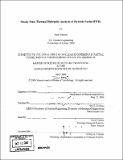| dc.contributor.advisor | Neil E. Todreas. | en_US |
| dc.contributor.author | Ferroni, Paolo, Ph. D. Massachusetts Institute of Technology | en_US |
| dc.contributor.other | Massachusetts Institute of Technology. Dept. of Nuclear Science and Engineering. | en_US |
| dc.date.accessioned | 2008-04-23T14:36:53Z | |
| dc.date.available | 2008-04-23T14:36:53Z | |
| dc.date.copyright | 2006 | en_US |
| dc.date.issued | 2006 | en_US |
| dc.identifier.uri | http://hdl.handle.net/1721.1/41263 | |
| dc.description | Includes bibliographical references (p. 205-208). | en_US |
| dc.description | Thesis (S.M.)--Massachusetts Institute of Technology, Dept. of Nuclear Science and Engineering, 2006. | en_US |
| dc.description.abstract | (cont.) Since the results obtained in the main body of the analysis account only for thermal-hydraulic constraints, an estimate of the power reduction due to the application of neutronic constraints is also performed. This investigation, focused only on the "New Core" cases, is coupled with an increase of the thickness of the gap separating adjacent bundles from 2 to 5 mm. Under these more conservative conditions, the power gain percentages are lower, ranging between 24% and 43% (depending on the discharge burnup considered acceptable) for the upper pressure drop limit, and between 17% and 32% for the lower pressure drop limit. | en_US |
| dc.description.abstract | (cont.) The benefits of the latter approach are evident since the space occupied by the bypass channel for cruciform control rod insertion becomes available for new fuel and a higher power can be achieved. The core power is constrained by applying thermal-hydraulic limits that, if exceeded, may induce failure mechanisms. These limits concern Minimum Critical Power Ratio (MCPR), core pressure drop, fuel average and centerline temperature, cladding outer temperature and flow-induced vibrations. To limit thermal-hydraulic instability phenomena, core power and coolant flow are constrained by fixing their ratio to a constant value. In particular, each BWR/5 core has been analyzed twice, each time with a different pressure drop limit: a lower limit corresponding to the pressure drop of the reference core and an upper limit 50% larger. It has been demonstrated that, in absence of neutronic constraints and with the maximum allowed pressure drop fixed at the upper limit, the implementation of the hydride fuel yields power gain percentages, with respect to oxide cores chosen as reference, of the order of 23% when its implementation is performed following the "Backfit" approach and even higher (50-70%) when greater design freedom is allowed in the core design, i.e. in the "New Core" approach. Should the maximum allowed pressure drop be fixed at the lower limit, the power gain percentage of the "Backfit" approach would decrease to 17%, while that of the "New Core" approach would remain unchanged, i.e. 50-70%. | en_US |
| dc.description.abstract | This thesis contributes to the Hydride Fuel Project, a collaborative effort between UC Berkeley and MIT aimed at investigating the potential benefits of hydride fuel use in Light Water Reactors (LWRs). Considerable work has already been accomplished on hydride fueled Pressurized Water Reactor (PWR) cores. This thesis extends the techniques used in the PWR analysis to examine the potential power benefits resulting from the implementation of the hydride fuel in Boiling Water Reactors (BWRs). This work is the first step towards the achievement of a complete understanding of the economic implications that may derive from the use of this new fuel in BWR applications. It is a whole core steady-state analysis aimed at comparing the power performance of hydride fueled BWR cores with those of typical oxide-fueled cores, when only thermal-hydraulic constraints are applied. The integration of these results with those deriving from a transient analysis and separate neutronic and fuel performance studies will provide the data required to build a complete economic model, able to identify geometries offering the lowest cost of electricity and thus to provide a fair basis for comparing the performance of hydride and oxide fuels. Core design is accomplished for two types of reactors: one smaller, a BWR/5, which is representative of existing reactors, and one larger, the ESBWR, which represents the future generation of BWRs. For both, the core design is accomplished in two ways: a "Backfit" approach, in which the ex-bundle core structure is identical to that of the two reference oxide cores, and a "New Core" approach, in which the control rods are inserted into the bundles in the form of control fingers and the gap between adjacent bundles is fixed optimistically at 2 mm. | en_US |
| dc.description.statementofresponsibility | by Paolo Ferroni. | en_US |
| dc.format.extent | 208 p. | en_US |
| dc.language.iso | eng | en_US |
| dc.publisher | Massachusetts Institute of Technology | en_US |
| dc.rights | M.I.T. theses are protected by
copyright. They may be viewed from this source for any purpose, but
reproduction or distribution in any format is prohibited without written
permission. See provided URL for inquiries about permission. | en_US |
| dc.rights.uri | http://dspace.mit.edu/handle/1721.1/7582 | en_US |
| dc.subject | Nuclear Science and Engineering. | en_US |
| dc.title | Steady state thermal hydraulic analysis of hydride fueled BWRs | en_US |
| dc.type | Thesis | en_US |
| dc.description.degree | S.M. | en_US |
| dc.contributor.department | Massachusetts Institute of Technology. Department of Nuclear Science and Engineering | |
| dc.identifier.oclc | 213415766 | en_US |
